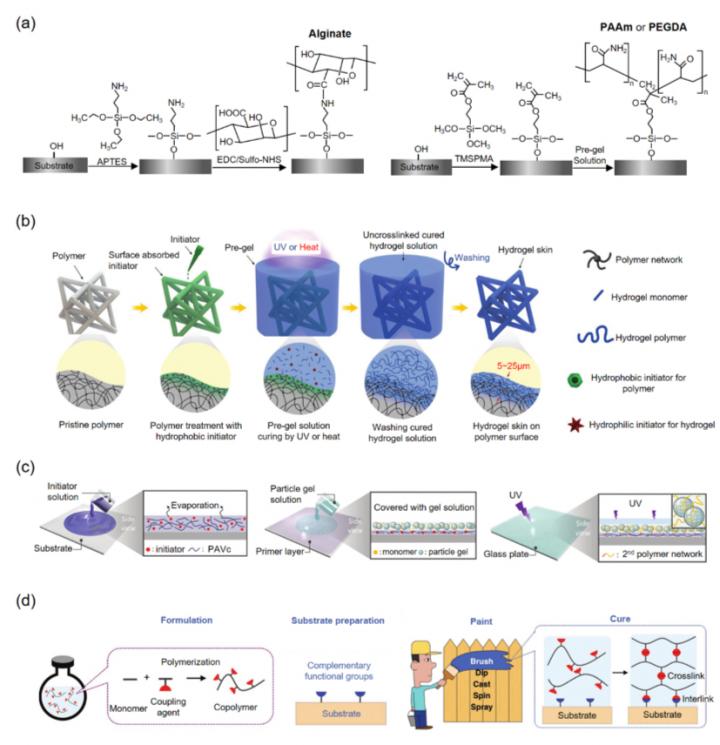Functions and applications, coating methods and adhesion tests

Credit: @Science China Press
Life originates from water. Hydrogels–hydrophilic polymer network swelling in water–resembles the original form of life, the algae and bacterium. In the modern life, hydrogels are ubiquitous in nature, from muscle and cartilage in animal tissues to xylems and phloems in plants. The intrinsic biocompatibility of hydrogels makes them prevailing in medical applications, such as wound dressing, drug delivery, and tissue scaffold.
In recent years, the diversity of synthetic hydrogels in topology and chemical composition of polymer network makes them highly adaptive to a vast array of functions and applications, such as stimuli responsive hydrogels by temperature, electrical field, and pH, lubricious hydrogels, anti-fouling hydrogels, and tough hydrogels. The synthetic hydrogels play an irreplaceable role in smart soft devices and soft robotics. Thanks to the achievement of strong bonding of hydrogels on various substrates, the applications of hydrogels have been further extended by functional hydrogel coatings. Through functional hydrogel coatings, one can integrate the functions of hydrogels or generates new applications by this combination without influence on the mechanical properties of the target substrates, such as stiffness, toughness, and strength. Functional hydrogel coating is one of the research hotspots of hydrogels.
Recently, Junjie Liu, Shaoxing Qu, and Wei Yang from Zhejiang University and Zhigang Suo from Harvard University reviewed the emerging topic of functional hydrogel coatings from three aspects: functions and applications of hydrogel coatings, methods of preparing hydrogel coatings with strong adhesion, and tests to evaluate the adhesion. This review, entitled “Functional hydrogel coatings”, was published in the National Science Review.
Firstly, the main functions and applications of functional hydrogel coatings in both medical and non-medical areas are presented. In non-medical area, typical applications include sensing, actuation, anti-marine creatures fouling and oil-water separation. While hydrogel coatings are used for drug delivery, lubrication, anti-biofouling and conductivity for neural electrodes in medical area.
This review pointed out that a well-established hydrogel coating method should be able to coat target substrates with arbitrary shape, achieve strong bonding between hydrogel coating and substrate, and be compatible with various hydrogels and substrates. The existing hydrogel coating methods that satisfy these requirements include the surface bridge method, the surface initiation method, and the hydrogel paint method, as illustrated in Figure 1.
Adhesion between the hydrogel coating and substrate, which is the energy required to peel away a unit area of hydrogel coating and has units of J/m2, quantifies the resistance to debonding of the coating. Tests for adhesion of hydrogel coatings include the peel test, the simple stretch test, the scratch test, the probe pull test, and the double cantilever beam test. These test methods are schematically illustrated in Figure 2. Among these, the peel test is the most frequently used one.
Finally, the authors proposed several research directions of the functional hydrogel coatings:
- 1. To optimize hydrogel coating methods for the translation to mass production;
2. The long term stability of functional hydrogel coatings in aqueous environment, such as in seawater, body fluid, and blood;
3. The fatigue of stretchable hydrogel adhesion under cyclic loading;
4. A general method for testing the adhesion of hydrogel coating with extreme thin thickness.
###
See the article:
Junjie Liu, Shaoxing Qu, Zhigang Suo, and Wei Yang
Functional Hydrogel Coatings
Natl Sci Rev nwaa254
https:/
Media Contact
Wei Yang
[email protected]
Related Journal Article
http://dx.




